Controverscial.Com
![]()
Welcome
![]()
|
Controverscial.Com
Welcome
|
|
|
Controverscial.Com
Welcome
|



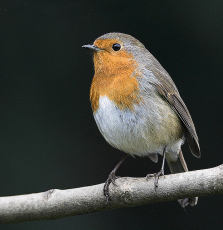
(Erithacus rubecula)
The European Robin (Erithacus rubecula) is a small, plump, migratory songbird closely related to thrushes. The Robin is affectionately known as “Robin Redbreast” and is undoubtedly one of the best-loved garden birds of Great Britain. His fame is perhaps due to his visible re-appearance at Christmas-time hopping and singing around our gardens where he lives in close proximity to humans. The Robin is Britain’s national bird. After a survey conducted through the pages of The Times in 1960, the Council for Bird Preservation conferred the title “Bird of Britain” on the Robin in 1961.
European Robins are widely distributed and can be found in countries all across Europe and as far as central Siberia. They are also found in parts of Asia, North Africa, Turkey and the Azores. The North American Robin (Turdus migratorius) also belongs to the thrush family, but is generally larger and slimmer than its English counterpart, while in Australia and New Guinea there are several other unrelated songbirds also known as Robin. In England, Robins are normally territorial and will stay in the same area throughout their lives, but some are known to migrate short distances and return in winter close to Christmas-time.
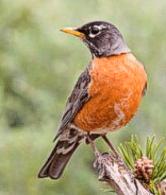
(Turdus migratorius)
The European Robin has a grey-brown coat with a distinctive orangey-red throat and chest (hence the familiar name “Robin Redbreast”) trailing down to a white belly and under-tail. They are generally small and plumpish birds growing only to about 12-13cm (5-5½in). Both the male and female have the same coat and colouring, while their young are mottled with greys, browns and buff colours. Robins like to build their nests in sheltered places, such as in hollowed out tree stumps or holes in the ground, into which they use moss, roots, twigs, grass, rags, paper and feathers to form cup-shaped nests. They will also make use of any undisturbed planting pots and other suitable containers found lying about in gardens.
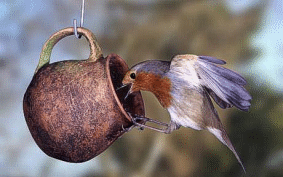
During the late winter or early spring, male Robins will seek out their own territories, usually an area of approximately half a hectare, which he defends against all other Robins. Perching himself on the edge of his territory he will declare the area his by singing. Short bursts of singing are followed by short silences, during which he listens for neighbours and potential rivals. If a rival approaches he will sing louder in warning before flying out to challenge the intruder. If they meet and often they do, he’ll puff out his red breast and hop around in a ritual display of threatening behaviour. If that fails to keep the rival away, he will then aggressively attack the intruder, which can result in serious injury and even death. Such attacks account for up to 10% of fatalities in the adult Robin population.
Robins have a trilling clear voice and both male and female will sing throughout the year. The male makes use his singing skills to attract females, but at first he will drive them away, and only if she persists will she be accepted. The pair will then form a bond, which is strengthened in courtship by the male feeding the female (or as Shakespeare puts it in his play The Two Gentlemen of Verona: “Win her with gifts if she respect not words”).
Robins are generally ground feeding birds, their main food source being flies, insects, spiders and worms, and in winter - berries, soft fruit and seeds. The paired Robins will begin to breed from April to June each year, during which time the female will lay five to six yellowish, light-brown speckled eggs, and incubate them for 14 days before they hatch. Both parents feed their young until they are able to fly, which is normally after 12 to 15 days. The paired Robins will usually produce two broods each year, although occasionally they may even produce a third.
Male Robins have an average life expectancy of 1.1 years, which is probably due to their aggressive attacks on rival birds. However, if they can survive past their first year, they can expect to live much longer. One such has been recorded living to the age of 12 years. The Robin's main predator is the domestic cat, which kills 15 times as many Robins as do his other predators, the Sparrowhawk and Owl. Another main cause for such a low life expectancy is severe weather conditions. Low temperatures in winter make the ground very hard, this followed by heavy snow falls can make the Robin's natural foraging for food difficult. In extreme conditions this can lead to fatalities and a significant drop in their population.
Scientific classification:
The European Robin is classified as:
Erithacus rubecula, the American Robin as Turdus migratorius,
the Indian Robin as: Saxicoloides
fulicata, the Pekin or Chinese Robin as:
Leiothrix lutea, the Australian Scarlet Robin as:
Petroica multicolour and the African/Asian
Magpie Robin Copsychus saularis. The
Magpie Robin is also the national bird of Bangladesh.
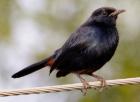
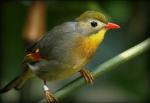
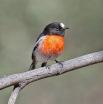
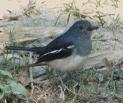
The Robin has long been associated with Christmas particularly in Great Britain. During the reign of Queen Victoria (1837-1901) with the introduction of the world’s first unified postage stamp – the famous “Penny Black” in 1840, the Royal Mail postal service in Britain rapidly expanded to include the general public. As a consequence of this reform, there was a steady increase in the public use of the service necessitating the employment of a growing army of letter carriers, thereafter renamed postmen.

Initially the postmen were servants of the Crown whose national colour was red, and so the first postmen in Britain wore a bright red liveried uniform, as such they were given a common nickname and became known as “Robin Redbreasts”. At that time and until well into the 20th century, postal deliveries were made 364 days of the year, which included Christmas day, and so the Robin, the Postman and the gifts he brought became associated. Many old Christmas cards depicted Robins delivering the mail.
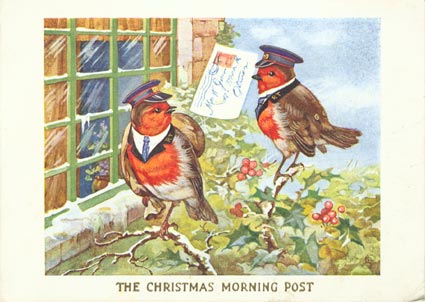
The Robin throughout history has been variously associated with charity, compassion, good luck, bad luck, fire and death; as such he has become a legend in the folklore of many countries. Many stories about the Robin attempt to explain the origin of his red breast, the most common being associated with the birth and death of Christ. One such story relates that when Jesus was crucified on the cross, a Robin flew down and removed a thorn from the crown on his head to relieve some of his suffering. In doing so, the blood of Jesus stained his throat and chest, and ever since his breast has remained red.
In a similar story concerning the birth of Christ, a Robin flew
into the stables where the baby Jesus was born. Seeing Mary and the boy child sleeping, the Robin noticed a
nearby fire had almost gone out, and while fanning the embers back into flame, he
burnt and singed his breast feathers. Mary
blessed him for his courage, and when his feathers grew back again they remained
red in recognition of his efforts.
Because of his red breast and this association with fire, like the Raven in mythology, the Robin is said to have brought fire from heaven. As such, in folklore, Robins are considered holy birds, and are beloved by gardeners for they remind him of paradise and the legendary Garden of Eden. A similar myth has it that the Robin was a storm-cloud bird held sacred by Thor, the god of Thunder in Norse mythology.
In the old folklore traditions of Great Britain, if a Robin pecks at your window or enters your house, it is likely a death will soon occur there. Likewise, if a Robin flies into a house through an open window, it was taken as a sign of death being present. This idea is thought to have come from an old 16th century folktale called “Babes in the Wood”, which implies that if a Robin finds a human corpse, it would cover the corpse with moss, leaves and flowers, effectively burying it.
First published as a ballad by Thomas Millington in Norwich 1595, the “Babes in the Wood” tale has been reworked into many forms:
Thus
wandered these poor innocents,
Till death did end their grief;
In one another's arms they died,
As wanting due relief;
No burial this pretty pair
Of any man receives,
Till Robin Redbreast piously
Did cover them with leaves.
It was said to be
extremely unlucky to kill a Robin, and the hand that does so will continue to
shake thereafter. If
a farmer causes the death, he should expect his barn to catch fire or his cow’s
milk to flow the colour of blood.
It was a common belief
in both Britain and Ireland that whatever tragedy befalls the Robin, the person
who caused it would suffer the same consequence.
If a person destroyed the
nest of a Robin, he should expect a death in his family within a year, or a fire
to destroy his house, or lightning to strike it and damage it.
Breaking the eggs of a
Robin will result in something valuable of your own being broken.
To see a Robin sheltering in the branches of a tree indicates that rain
is on the way, and to see one chirping on an open branch indicates that fine
weather is coming. You should make
a wish when you see your first Robin of the season, and make sure to do it
quick, for if the bird flies away beforehand, you’ll receive no good luck for
the next twelve months.
Another association of the Robin with death is in a pagan belief. In Celtic traditions, Yule is the time when the Oak King triumphs over the Holly King. The Holly King represents the death and darkness that has ruled since the onset of Samhain (Halloween). At the time of the Winter Solstice, the Oak King is reborn and begins a new cycle of life and lightness. A similar version of the Oak King versus the Holly King theme is the killing of the Wren. The Wren is the little King of the Waning Year, and is killed by the Robin Redbreast, the new King of the Waxing Year.
Penguin Hutchinson Reference Library Copyright (c) 1996 Helicon Publishing and Penguin Books Ltd
Microsoft ® Encarta ® 2006. © 1993-2005 Microsoft Corporation. All rights reserved.
Encyclopædia Britannica 2005 Ultimate Reference Suite DVD. Copyright © 1994-2003
Encyclopedia Mythica: http://www.pantheon.org/articles/g/goblin.html
http://www.birdguides.com/species/species.asp?sp=130019
Plus too many more to mention.
![]()
![]()

Let there be peace in the world - Where have all the flowers gone?
My Personal Page / My Place in England, UK / My Family Tree (Ancestry)
Wicca/Witchcraft / What is Wicca / What is Magick
Traditional Writings:
Wiccan Rede / Charge of the Goddess / Charge of the God / The Three-Fold Law (includes The Law of Power and The Four Powers of the Magus) / The Witches Chant / The Witches Creed / Descent of the Goddess / Drawing Down the Moon / The Great Rite Invocation / Invocation of the Horned God / The 13 Principles of Wiccan Belief / The Witches Rede of Chivalry / A Pledge to Pagan Spirituality
Correspondence Tables:
Incense / Candles / Colours / Magickal Days / Stones and Gems / Elements and Elementals
Traditions Part 1 - Alexandrian Wicca / Aquarian Tabernacle Church (ATC) / Ár Ndraíocht Féin (ADF) / Blue Star Wicca / British Traditional (Druidic Witchcraft) / Celtic Wicca / Ceremonial Magic / Chaos Magic / Church and School of Wicca / Circle Sanctuary / Covenant of the Goddess (COG) / Covenant of Unitarian Universalist Pagans (CUUPS) / Cyber Wicca / Dianic Wicca / Eclectic Wicca / Feri Wicca /
Traditions Part 2 - Gardnerian Wicca / Georgian Tradition / Henge of Keltria / Hereditary Witchcraft / Hermetic Order of the Golden Dawn (H.O.G.D.) / Kitchen Witch (Hedge Witch) / Minoan Brotherhood and Minoan Sisterhood Tradition / Nordic Paganism / Pagan Federation / Pectic-Wita / Seax-Wica / Shamanism / Solitary / Strega / Sylvan Tradition / Vodoun or Voodoo / Witches League of Public Awareness (WLPA) /
Gods and Goddesses (Greek
Mythology) / Esbats &
Full Moons / Links
to Personal Friends & Resources / Wicca/Witchcraft
Resources / What's a spell? /
Circle Casting and
Sacred Space / Pentagram
- Pentacle / Marks
of a Witch / The Witches
Power / The Witches Hat
/ An
esoteric guide to visiting London / Satanism
/ Pow-wow
/ The
Unitarian Universalist Association / Numerology: Part 1
/ Part 2 / Part
3 / A
history of the Malleus Maleficarum: includes: Pope
Innocent VIII /
The
papal Bull /
The
Malleus Maleficarum /
An extract from the Malleus Maleficarum
/ The letter of approbation
/ Johann
Nider’s Formicarius /
Jacob
Sprenger /
Heinrich Kramer /
Stefano Infessura
/ Montague Summers /
The Waldenses
/ The Albigenses
/
The Hussites / The
Sun Dance
/ Shielding (Occult
and Psychic Protection) /
Sabbats in History and Mythology / Samhain (October 31st) / Yule (December 21st) / Imbolc (February 2nd) / Ostara (March 21st) / Beltane (April 30th) / Litha (June 21st) / Lughnasadh (August 1st) / Mabon (September 21st)
Rituals contributed by Crone: Samhain / Yule / Imbolc / Ostara / Beltane / Litha / Lammas / Mabon
Tools of a Witch / The Besom (Broom) / Poppets and Dolls / Pendulums / Cauldron Magick / Mirror Gazing
Animals in Witchcraft (The Witches Familiar) / Antelope / Bats / Crow / Fox / Frog and Toads / Goat / Honeybee / Kangaroo / Lion / Owl / Phoenix / Rabbits and Hares / Raven / Robin Redbreast / Sheep / Spider / Squirrel / Swans / Wild Boar / Wolf / Serpent / Pig / Stag / Horse / Mouse / Cat
In Worship of Trees - Myths, Lore and the Celtic Tree Calendar. For descriptions and correspondences of the thirteen sacred trees of Wicca/Witchcraft see the following: Birch / Rowan / Ash / Alder / Willow / Hawthorn / Oak / Holly / Hazel / Vine / Ivy / Reed / Elder. Also see: The Willow Tree (Folk Music)
Mystical Sacred Sites - Stonehenge / Glastonbury Tor / Malta - The Hypogeum of Hal Saflieni / Avebury / Cerne Abbas - The Chalk Giant / Ireland - Newgrange /
Rocks and Stones:
Stones - History, Myths and Lore
Articles contributed by Patricia Jean Martin: / Apophyllite / Amber / Amethyst / Aquamarine / Aragonite / Aventurine / Black Tourmaline / Bloodstone / Calcite / Carnelian / Celestite / Citrine / Chrysanthemum Stone / Diamond / Emerald / Fluorite / Garnet / Hematite / Herkimer Diamond / Labradorite / Lapis Lazuli / Malachite / Moonstone / Obsidian / Opal / Pyrite / Quartz (Rock Crystal) / Rose Quartz / Ruby / Selenite / Seraphinite / Silver and Gold / Smoky Quartz / Sodalite / Sunstone / Thunderegg / Tree Agate / Zebra Marble
Wisdom:
Knowledge vs Wisdom by Ardriana Cahill / I Talk to the Trees / Awakening / The Witch in You / A Tale of the Woods
Articles and Stories about Witchcraft:
Murder by Witchcraft / The Fairy Witch of Clonmel / A Battleship, U-boat, and a Witch / The Troll-Tear (A story for Children) / Goody Hawkins - The Wise Goodwife / The Story of Jack-O-Lantern / The Murder of the Hammersmith Ghost / Josephine Gray (The Infamous Black Widow) / The Two Brothers - Light and Dark
Old Masters of Academia:
Pliny the Elder / Hesiod / Pythagoras
Abramelin the Mage / Agrippa / Aidan A. Kelly / Albertus Magnus “Albert the Great” / Aleister Crowley “The Great Beast” / Alex Sanders "the King of the Witches” / Alison Harlow / Amber K / Anna Franklin / Anodea Judith / Anton Szandor LaVey / Arnold Crowther / Arthur Edward Waite / Austin Osman Spare / Biddy Early / Bridget Cleary / Carl Llewellyn Weschcke / Cecil Hugh Williamson / Charles Godfrey Leland / Charles Walton / Christina Oakley Harrington / Damh the Bard (Dave Smith) / Dion Fortune / Dolores Aschroft-Nowicki / Dorothy Morrison / Doreen Valiente / Edward Fitch / Eleanor Ray Bone “Matriarch of British Witchcraft” / Dr. John Dee and Edward Kelly / Dr. Leo Louis Martello / Eliphas Levi / Ernest Thompson Seton / Ernest Westlake and the Order of Woodcraft Chivalry / Fiona Horne / Friedrich von Spee / Francis Barrett / Gerald B. Gardner / Gavin and Yvonne Frost and the School and Church of Wicca / Gwydion Pendderwen / Hans Holzer / Helen Duncan / Herman Slater "Horrible Herman" / Israel Regardie / James "Cunning" Murrell / Janet Farrar & Gavin Bone / Jessie Wicker Bell “Lady Sheba” / John Belham-Payne / John George Hohman / John Gerard / John Gordon Hargrave (the White Fox) / John Michael Greer / John Score / Johannes Junius the Burgomaster of Bamberg / Joseph John Campbell / Karl von Eckartshausen / Laurie Cabot "the Official Witch of Salem" / Lewis Spence / Margaret Alice Murray / Margot Adler / Marie Laveau the " Voodoo Queen of New Orleans" / Marion Weinstein / Matthew Hopkins “The Witch-Finder General” / Max Ehrmann and the Desiderata / Monique Wilson the “Queen of the Witches” / Montague Summers / Nicholas Culpeper / Nicholas Remy / M. R. Sellers / Mrs. Grieve "A Modern Herbal" / Oberon and Morning Glory Zell-Ravenheart / Old Dorothy Clutterbuck / Old George Pickingill / Paddy Slade / Pamela Colman-Smith / Paracelsus / Patricia Crowther / Patricia Monaghan / Patricia “Trish” Telesco / Philip Emmons Isaac Bonewits / Philip Heselton / Raymond Buckland / Reginald Scot / Robert Cochrane / Robert ‘von Ranke’ Graves and "The White Goddess" /
Rudolf Steiner / Rosaleen Norton “The Witch of Kings Cross” / Ross Nichols and The Order of Bards, Ovates & Druids / Sabrina - The Ink Witch / Scott Cunningham / Selena Fox / Silver Ravenwolf / Sir Francis Dashwood / Sir James George Frazer / S.L. MacGregor Mathers and the “Hermetic Order of the Golden Dawn” / Starhawk / Stewart Farrar / Sybil Leek / Ted Andrews / The Mather Family - includes: Richard Mather, Increase Mather, Cotton Mather / Thomas Ady / Vera Chapman / Victor Henry Anderson / Vivianne Crowley / Walter Brown Gibson / William Butler Yeats / Zsuzsanna Budapest
Many of the above biographies are brief and far from complete. If you know about any of these individuals and can help with aditional information, please cantact me privately at my email address below. Many thanks for reading :-)
While I have taken due care and dilligence to credit all sources where possible, this website may contain copyrighted material which has not been specifically authorized by the copyright owner. My use of making such material available here is done so in my efforts to advance our understanding of religious discrimination, the environmental and social justice issues etc. If you wish to use copyrighted material from this wedsite for purposes of your own then you must obtain permission from the relevant copyright owner yourself.
![]()
My online email discussion group:
http://groups.yahoo.com/group/Email_Witches

Help send a message of peace around the world! The Dove of Peace flies from site to site, through as many countries as possible. It does not belong to ANY belief system. Please help make a line around the globe by taking it with you to your site, by giving it to someone for their site, by passing it on to another continent or to the conflict areas of the world. May trouble and strife be vanquished in it's path.

mailto:George@controverscial.com
![]()
|
|